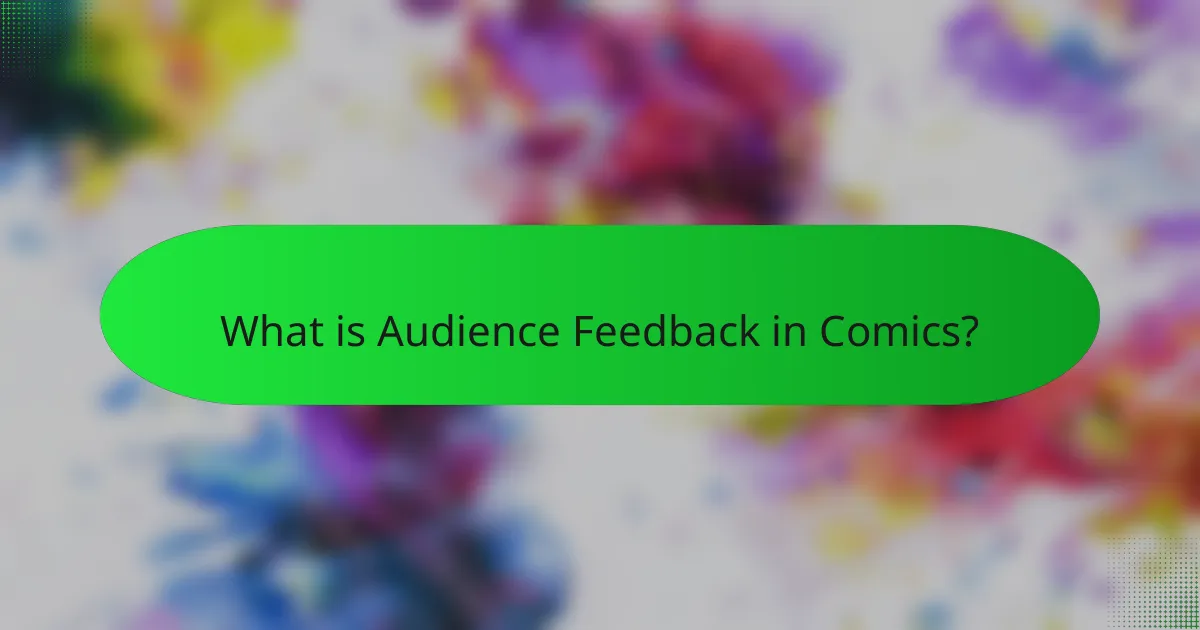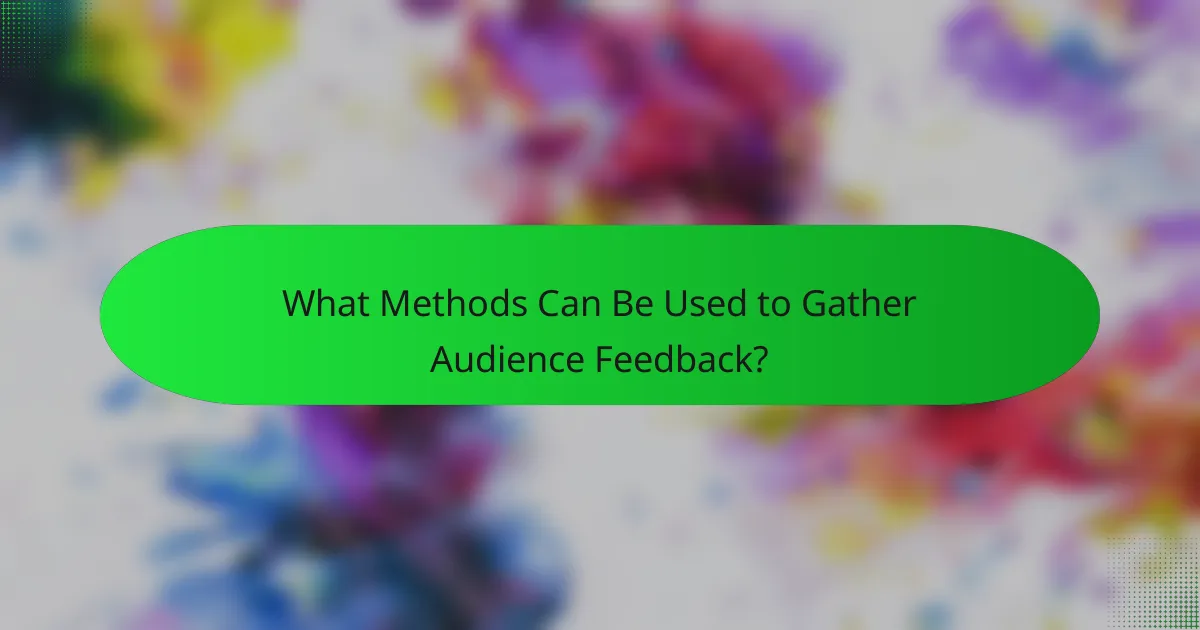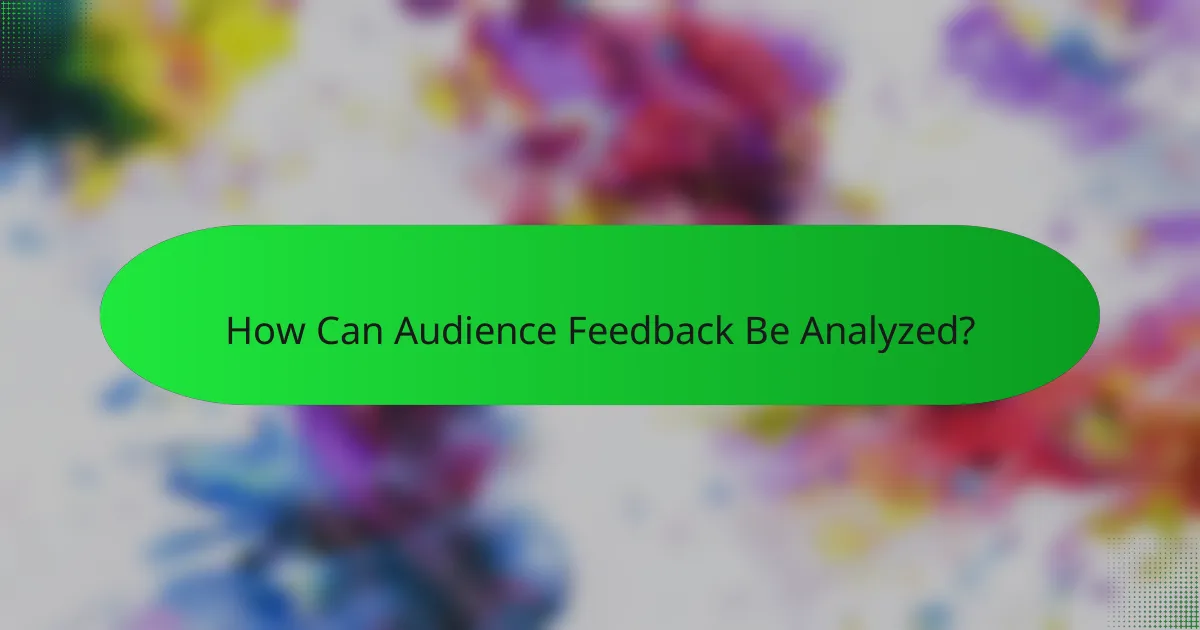Audience feedback in comics encompasses the reactions and opinions of readers regarding various elements such as storylines, characters, and artwork. This feedback is crucial for comic creators to understand audience preferences and enhance their work. Effective methods for gathering feedback include surveys, social media interactions, interviews, and focus groups, each providing valuable insights into reader engagement. Analyzing this feedback through techniques like sentiment analysis and content analysis helps identify trends and areas for improvement, ultimately fostering a stronger connection between creators and their audience.

What is Audience Feedback in Comics?
Audience feedback in comics refers to the reactions and responses from readers regarding a comic’s content. This feedback can include opinions on storylines, characters, and artwork. It is essential for creators to understand audience preferences and improve their work. Methods for gathering this feedback include surveys, social media interactions, and fan conventions. Analyzing audience feedback helps identify trends and areas for enhancement. For example, creators can adjust narratives based on common themes in reader responses. This process fosters a connection between creators and their audience, enhancing future comic productions.
How does audience feedback impact comic creation?
Audience feedback significantly influences comic creation. It helps creators understand reader preferences and interests. Feedback can guide story arcs, character development, and artistic style. For instance, positive responses may encourage a continuation of certain themes. Conversely, negative feedback can prompt revisions or a shift in direction. Many creators utilize social media to gather real-time reactions. This immediate input allows for adjustments in ongoing series. Studies show that comics reflecting audience desires often achieve greater success. Audience engagement fosters a collaborative relationship between creators and readers.
What are the main types of audience feedback?
The main types of audience feedback are qualitative and quantitative feedback. Qualitative feedback consists of subjective opinions, comments, and insights from the audience. This type provides in-depth understanding of audience perceptions and emotions. Quantitative feedback involves measurable data, such as ratings and surveys. This type allows for statistical analysis of audience responses. Both types are essential for comprehensive audience analysis. They help creators refine their work based on audience preferences and experiences.
How does feedback influence storytelling in comics?
Feedback significantly influences storytelling in comics by shaping narrative direction and character development. Creators often adjust plots based on reader reactions. Positive feedback can encourage the continuation of certain themes or character arcs. Conversely, negative feedback may lead to revisions or the removal of unpopular elements. This iterative process enhances engagement and aligns the story with audience expectations. Studies show that comics with responsive storytelling often achieve higher reader satisfaction. For instance, webcomics frequently adapt to real-time feedback, demonstrating the impact of audience responses on ongoing narratives.
Why is gathering audience feedback important?
Gathering audience feedback is important because it informs creators about audience preferences and experiences. This feedback helps in refining content to better meet audience expectations. It can reveal strengths and weaknesses in storytelling, character development, and artwork. According to a study by the Journal of Interactive Media, 78% of creators who utilized audience feedback improved their subsequent works. Additionally, audience feedback fosters community engagement and loyalty. Engaged audiences are more likely to support future projects and share their positive experiences. Therefore, gathering audience feedback is essential for continuous improvement and audience satisfaction in comics.
What role does feedback play in improving comic quality?
Feedback plays a crucial role in improving comic quality. It helps creators identify strengths and weaknesses in their work. Audience reactions provide insights into character development, plot pacing, and artwork effectiveness. Constructive criticism can guide revisions and enhance storytelling. For example, surveys and focus groups can reveal what resonates with readers. This data-driven approach leads to more engaging content. Ultimately, feedback fosters a collaborative relationship between creators and their audience. By responding to feedback, comics can evolve to meet reader expectations and preferences.
How can audience feedback enhance reader engagement?
Audience feedback can enhance reader engagement by providing insights into reader preferences and interests. This feedback allows creators to tailor content to meet the audience’s expectations. Engaging with feedback fosters a sense of community among readers. It also encourages dialogue between creators and their audience, making readers feel valued. Studies show that content adjusted based on feedback can lead to higher satisfaction rates. For example, a survey by the Pew Research Center found that 70% of readers appreciate when creators respond to their comments. This interaction can significantly boost loyalty and repeat readership.

What Methods Can Be Used to Gather Audience Feedback?
Surveys and questionnaires are effective methods to gather audience feedback. These tools allow creators to collect structured responses from readers. Online platforms can facilitate easy distribution and data collection. Interviews provide deeper insights through direct interaction with the audience. Focus groups encourage discussion and diverse opinions among participants. Social media platforms enable real-time feedback and engagement. Analytics tools track audience behavior and preferences based on their interactions. Each method yields valuable data to improve comic content and reader satisfaction.
What are the most effective techniques for collecting feedback?
Surveys are one of the most effective techniques for collecting feedback. They allow for structured questions that can quantify audience responses. Online tools like Google Forms or SurveyMonkey facilitate easy distribution and analysis. Interviews provide in-depth insights through direct conversation. This technique captures nuanced opinions that surveys might miss. Focus groups encourage discussion among participants, revealing collective insights. Observational methods allow researchers to see how audiences interact with comics in real-time. Feedback forms at events or on websites gather immediate reactions. Each technique has its strengths, depending on the context and desired depth of feedback.
How do surveys contribute to understanding reader responses?
Surveys provide structured data that reveals reader preferences and opinions. They allow creators to gather quantitative and qualitative feedback. This feedback can highlight trends in reader engagement and satisfaction. Surveys can identify specific aspects of content that resonate with audiences. They can also uncover areas needing improvement. For example, a survey might reveal that readers prefer certain themes or characters. Analyzing survey results can guide future content creation. Overall, surveys are essential tools for understanding and enhancing reader experiences.
What is the role of social media in gathering feedback?
Social media plays a crucial role in gathering feedback from audiences. It allows for immediate interaction between creators and their audience. Platforms like Twitter, Facebook, and Instagram facilitate real-time discussions. Users can share their opinions, comments, and reviews directly. This instant feedback helps creators understand audience preferences. According to a 2021 survey by Pew Research Center, 69% of adults use social media, making it a valuable tool for feedback collection. Furthermore, engagement metrics on these platforms provide quantitative data on audience reactions. This data can guide creators in refining their work. Thus, social media is an essential avenue for obtaining audience feedback in the comics industry.
What tools can assist in the feedback collection process?
Surveys are effective tools for collecting feedback. They can be distributed online or in print. Platforms like SurveyMonkey and Google Forms simplify survey creation and distribution. Feedback forms allow for structured responses, making analysis easier. Focus groups provide qualitative insights through discussions. Tools like Zoom can facilitate remote focus group sessions. Social media platforms enable real-time feedback collection. Analytics tools track engagement metrics, offering indirect feedback. Each tool serves a unique purpose in gathering audience responses effectively.
How can online platforms facilitate reader engagement?
Online platforms can facilitate reader engagement through interactive features. These features include comment sections, polls, and forums. Such tools allow readers to share their thoughts and opinions. Instant feedback mechanisms encourage real-time interaction. Additionally, platforms can utilize social media integration. This enables sharing content easily and reaching a wider audience. Analytics tools help track reader behavior and preferences. Understanding these metrics informs content creators about audience interests. Research shows that engagement increases when readers feel involved in the conversation.
What technology is available for analyzing audience responses?
Technology available for analyzing audience responses includes survey tools, social media analytics, and sentiment analysis software. Survey tools like SurveyMonkey and Google Forms collect direct feedback from audiences. Social media analytics platforms, such as Hootsuite and Sprout Social, track engagement and audience reactions. Sentiment analysis software, like Lexalytics and MonkeyLearn, evaluates audience emotions in text data. These tools provide quantitative and qualitative insights into audience preferences and behaviors. They are widely used in various industries, including comics, to enhance content and engagement strategies.

How Can Audience Feedback Be Analyzed?
Audience feedback can be analyzed through various methods. Surveys and questionnaires collect quantitative data on reader preferences. Focus groups provide qualitative insights into audience perceptions. Social media monitoring tracks audience reactions in real-time. Content analysis examines themes and patterns in feedback. Sentiment analysis uses algorithms to determine emotional responses. Each method offers unique advantages for understanding audience engagement. For instance, a study by the Pew Research Center indicates that surveys yield statistically significant trends in audience preferences.
What techniques are used for analyzing feedback data?
Common techniques for analyzing feedback data include qualitative analysis, quantitative analysis, and sentiment analysis. Qualitative analysis involves examining open-ended responses for themes and patterns. This technique helps to understand deeper insights into audience sentiments. Quantitative analysis uses statistical methods to analyze numerical feedback data. It provides measurable insights into audience preferences. Sentiment analysis employs natural language processing to determine the emotional tone of feedback. This technique categorizes responses as positive, negative, or neutral. These methods collectively enhance understanding of audience feedback in the context of comics.
How does qualitative analysis differ from quantitative analysis?
Qualitative analysis focuses on understanding underlying reasons and motivations, while quantitative analysis emphasizes numerical data and statistical methods. Qualitative analysis often involves interviews, open-ended surveys, and observations to gather in-depth insights. This approach captures nuances and complex emotions that numbers alone cannot convey. In contrast, quantitative analysis uses structured tools like surveys with closed-ended questions to collect measurable data. It enables researchers to identify patterns and correlations through statistical techniques. For instance, qualitative findings may reveal why readers connect with specific comic characters emotionally, while quantitative data can show how many readers prefer a particular genre. Both methods complement each other in providing a comprehensive understanding of audience feedback.
What metrics are most useful for evaluating reader responses?
Engagement metrics are most useful for evaluating reader responses. These metrics include comments, shares, and likes. Comments indicate reader interaction and sentiment. Shares reflect the content’s reach and resonance. Likes provide a quick measure of approval. Additionally, reading time can indicate how engaged readers are with the material. Bounce rates show how many readers leave after viewing only one page. These metrics help gauge overall reader satisfaction and interest in comics.
How can feedback analysis inform future comic projects?
Feedback analysis can significantly inform future comic projects by identifying reader preferences and areas for improvement. Analyzing feedback reveals which storylines resonate with audiences. It also highlights characters that readers find compelling or unappealing. This information allows creators to refine their narratives and character development. Additionally, feedback can uncover pacing issues or visual elements that may need adjustment. By incorporating reader suggestions, creators can enhance engagement and satisfaction. Studies show that audience-driven adjustments can lead to increased sales and loyalty. Therefore, feedback analysis serves as a vital tool for successful comic project development.
What strategies can creators use to implement feedback effectively?
Creators can implement feedback effectively by categorizing it into actionable items. They should prioritize feedback based on its relevance and frequency. This allows creators to focus on the most impactful changes. Additionally, creators should communicate with their audience about how feedback has influenced their work. This builds trust and encourages further engagement. Using tools like surveys can help gather structured feedback. Analyzing feedback trends over time can highlight areas for improvement. Lastly, creators should remain flexible and open to evolving their content based on audience needs. These strategies ensure that feedback is not only collected but also effectively integrated into the creative process.
How can audience feedback shape character development and plot direction?
Audience feedback can significantly shape character development and plot direction. It provides creators with insights into how characters resonate with readers. Positive feedback can lead to deeper exploration of beloved characters. Conversely, negative feedback may prompt changes or even the removal of certain characters.
Additionally, plot direction can be influenced by audience reactions to story arcs. If readers express dissatisfaction with a storyline, creators may alter its trajectory. Surveys and social media interactions often reveal audience preferences. For example, in comics, fan polls have led to the revival of certain storylines.
This feedback loop creates a dynamic relationship between creators and their audience. It allows for real-time adjustments that enhance engagement. Ultimately, audience feedback serves as a valuable tool for refining narratives.
What are best practices for gathering and analyzing audience feedback in comics?
Best practices for gathering and analyzing audience feedback in comics include using surveys, social media, and focus groups. Surveys allow creators to collect quantitative data from a broad audience. Social media platforms enable real-time feedback and engagement with readers. Focus groups provide in-depth qualitative insights through direct discussions with selected audience members.
Additionally, monitoring online reviews and comments helps identify trends in reader preferences. Engaging with fans during conventions can offer valuable face-to-face feedback. Analyzing this feedback helps creators refine their work based on audience preferences. Combining these methods enhances understanding of reader responses and improves future comic projects.
Audience feedback in comics is the collection of reader reactions regarding storylines, characters, and artwork, which is crucial for creators to enhance their work. The article outlines various methods for gathering feedback, including surveys, social media interactions, and focus groups, and explains how this feedback impacts comic creation, storytelling, and character development. It also discusses the importance of analyzing feedback to inform future projects and improve overall comic quality. Key strategies for effectively implementing and analyzing audience feedback are highlighted to foster a collaborative relationship between creators and their audience.